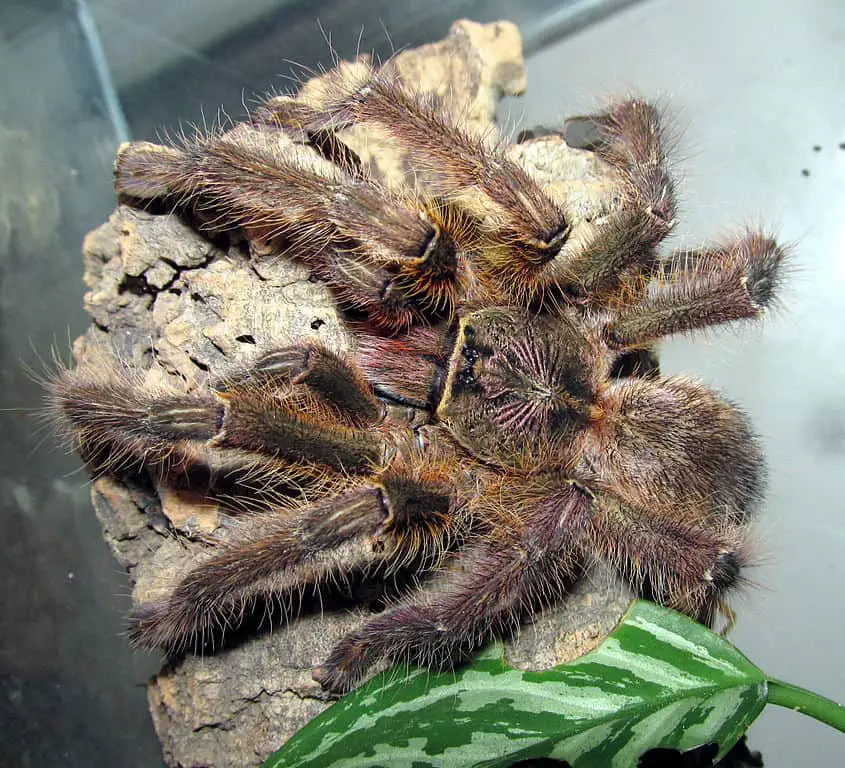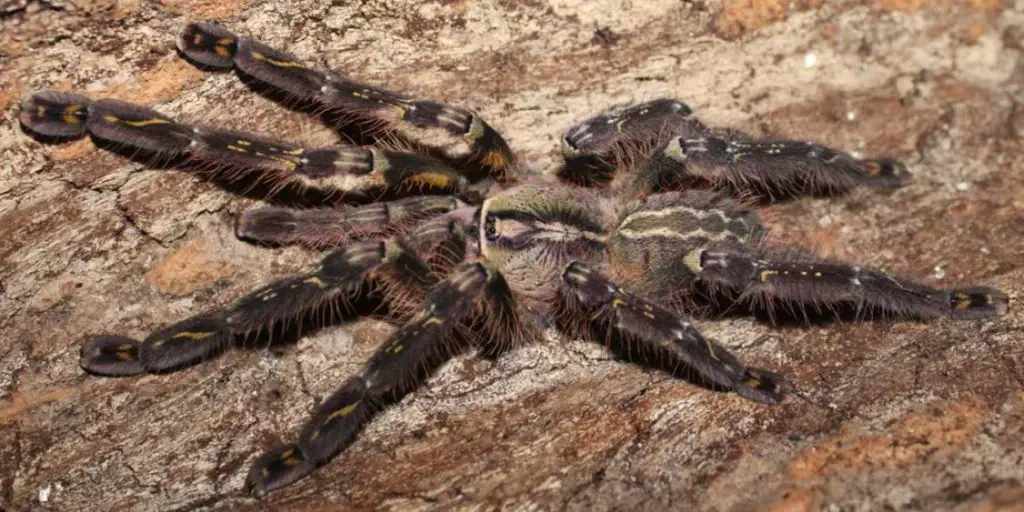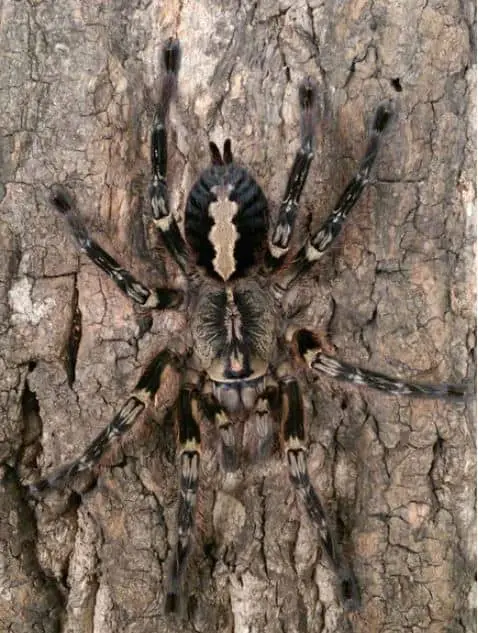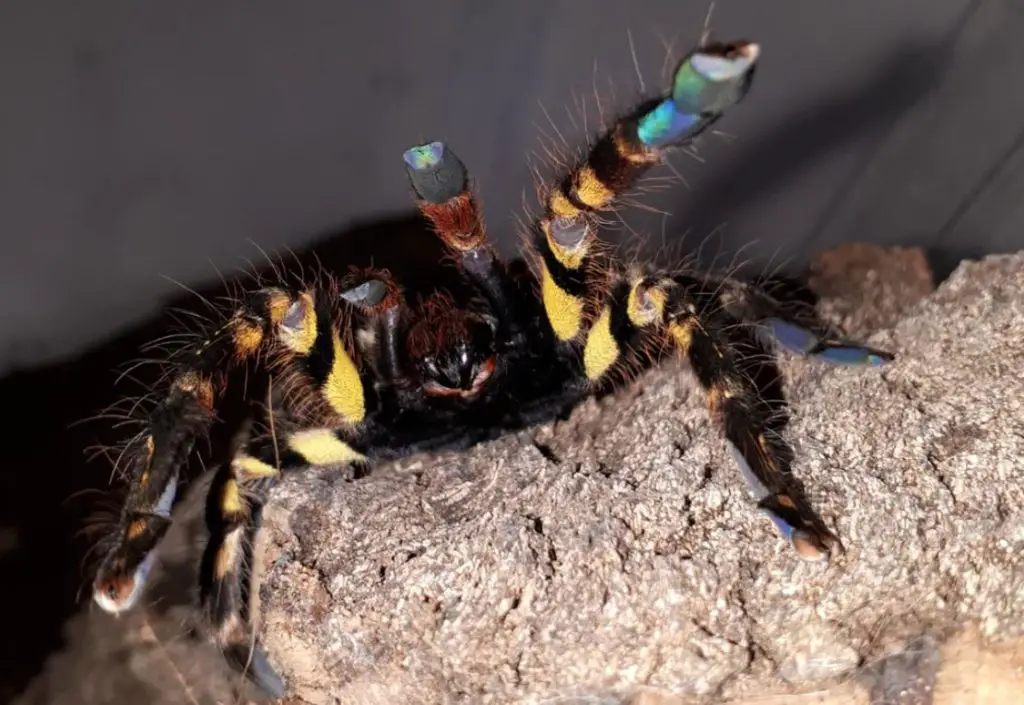The Fringed Ornamental Tarantula (Poecilotheria ornata) is a massive Old World arboreal spider native to Sri Lanka. Its fast movements and strong venom make it a dangerous spider that should only be kept and handled by the most experienced hobbyists. These spiders have a significant venom that can be quite threatening, even to humans.
It’s a tough spider, and yet it’s gorgeous to behold. It’s a huge spider that displays beautiful patterns over its long legs and abdomen. In the wild, she also displays a unique phenomenon where she develops a symbiotic relationship with a frog, the Ramanella nagaoi, more on that later.
If you’re considering adding this species to your collection, there is a thing or two that you should know about them. Keep reading, and you’ll be up to speed on this beautiful spider in no time. Of course, there will be plenty of pictures to give you an idea of what to expect from this beast of a spider.

Fringed Ornamental Tarantula Care Sheet
| Species Name | Poecilotheria ornata |
| Family Name | Theraphosidae |
| Common Names | Fringed Ornamental Tarantula, Yellow Legged Ornamental, Ornate parachute spider, Ornate tiger spider |
| Category | Old World |
| Type | Arboreal |
| Native Location | Sri Lanka |
| Body length | 3 inches (~8 cm) |
| Leg Span | 9.8 inches (~25 cm) |
| Growth Speed | Fast |
| Urticating Hairs | No |
| Social | Solitary |
| Diet | Crickets, roaches, mealworms. Also small birds in the wild. |
| Temperature | 75 to 85 degrees Fahrenheit |
| Humidity | 65 to 75% |
| Lifespan | Female: 12 years / Male: 3 years |
| Experience required | Intermediate |
| Minimum tank size | Three gallons, at least 12″ tall |
Fringed Ornamental Tarantula Overview
The Poecilotheria ornata has other names besides Fringed Ornamental Tarantula. It’s also known as Ornate Parachute Spider, Yellow Legged Ornamental Tarantula, and Ornate Tiger Spider. However, since it’s most commonly referred to in the hobby as the Fringed Ornamental tarantula, or FOT, so that’s what we’ll refer to it from here on out.
The Fringed Ornamental Tarantula is an arboreal spider native to Southwest Sri Lanka. It has large legs and a strong bite that lets it take out and eat birds by surprise; however, it’s happy to eat crickets in captivity.

It’s a defensive spider with dangerous venom, so it should be handled carefully.
Appearance & variations

The Fringed Ornamental Tarantula has light and dark patterns that give her a mesmerizing look. Its carapace has a greenish-yellow tinge as a base for the pattern.
They also have reddish-brown setae over their legs. Males make the contrast with a slightly darker yellow, while females make it with a darker purplish tone.
This species exhibits sexual dimorphism, which makes it easier to determine whether it’s a male or female specimen. Once they grow to a size of 2.5-3 inches, it’s easy to see if they either exhibit a dark pattern over their cephalothorax or not. Those with the dark purplish pattern are females.
These spiders are extremely large and their leg span can reach a size of almost 10 inches. Since they do not have a very long lifespan they grow extremely fast to reach this size in such a short time.
Price
A spiderling or juvenile Fringed Ornamental Tarantula can cost between $20 and $60, depending on where you purchase it. The cost of these spiders also depends on whether you buy a male or female.
An unsexed or adult male can be bought for as little as $60. Adults will cost anywhere from $120 to $200, with females going up to $240.
As is often the case with tarantulas, the females are quite a bit more expensive than the males. The reason for this is that females can live for up to 4 times longer.
Behavior and Temperament
The Fringed Ornamental Tarantula has more reported bites than other members of the Poecilotheria genus, so she’s particularly prone to biting as a defensive response.
She’s a very defensive spider, and her potent venom makes her quite dangerous. She’ll most likely strike a threat posture before going in for a bite; however, this doesn’t happen all the time. Sometimes they will attack without warning, so it’s better to stay alert at all times around her.
However, even though she’s dangerous, her first response will always be to flee instead of fighting. If she has enough places to hide and feel safe, and you approach her slowly, you should be able to deal with her safely.
Nevertheless, this is definitely not a spider for beginners and even experienced hobbyists should not handle this spider due to its significant venom and tendency to bite.
Caring for a Fringed Ornamental Tarantula

Temperature and Humidity
The Fringed Ornamental Tarantula lives in a hot and humid climate. Temperatures in her native territory range from 70°F to 90°F. In captivity, this spider does well in temperatures between 75°F and 85°F. The humidity should be around 65% to 75%.
It’s also very important to ensure that there is enough ventilation in the enclosure.
Substrate
The Fringed Ornamental Tarantula doesn’t spend time on the floor and does not burrow. She doesn’t need deep soil, so one inch of substrate is enough for spiderlings and younglings, while two inches are enough for adults.
The substrate can be dirt, but a mixture with peat moss will help retain the humidity; this creates a similar atmosphere to this specie’s natural habitat.
Tank
The Fringed Ornamental Tarantula is an arboreal spider; as such, she requires an enclosure that’s taller than wide and long.
Juveniles should be in tanks of at least two gallons. Due to their size and the speed of their movements, adults should always be in large enclosures of at least ten gallons.
You should add a vertical cork bark piece to allow them to climb. Other possible decoration pieces for your Fringed Ornamental Tarantula include sphagnum moss, artificial plants, and any decorative elements that may provide hiding places.
As long as the tarantula has enough places to hide and retreat, it’s less likely for her to attack. Tanks must also have safety lids since these spiders are prone to trying to escape when they see a chance.
Watering
The Fringed Ornamental Tarantula is used to a rainy climate, so it doesn’t hurt to water its substrate every now and then.
She doesn’t spend much time on the ground, but it’s still advisable to keep the substrate a bit moist at all times.
Additionally, you should keep a water dish inside the tank at all times and refill it constantly. This water dish could be superglued to the bark to make it easier for the FOT to drink.
Social
The Fringed Ornamental is not a tarantula that can live communally with other spiders. While they do form a symbiotic relationship with the Ramanella naganoi frog, this is only because both species benefit from it. They do not benefit from living with other tarantulas, so don’t house two of them together. In the wild, they only meet to breed, which is also how it should be in captivity.
Molting
Molting, the process of shedding the exoskeleton to make way for a bigger one, is a process that every tarantula goes through many times in their lives. However, because the P. Ornata is such a fast-growing spider, they molt quite frequently. When your tarantula is molting, try to not disturb them as this is quite a stressful time for them.
Diet & Feeding

The Fringed Ornamental Tarantula has a healthy appetite that matches her large size.
Spiderlings should eat a baby cricket twice a week. Make sure to pre-kill the cricket if you see the tarantula struggling with it.
Don’t feed the spiderlings right after a molt until at least five days have happened to give the fangs time to harden.
Juveniles should be fed one or two medium crickets every four to seven days. Wait five to seven days after a juvenile has molted to resume feeding them.
Adults can feed on small lizards or rodents, but it’s safer to feed them six to ten large crickets or two to three B. dubia roaches, every ten to fifteen days.
Wait for at least ten days after a molt to resume feeding the adult FOT.
Health & Lifespan
The Fringed Ornamental Tarantula is a relatively hardy species. In captivity, they can easily live their full lifespan which is about 12 years for females and around 3 years for males.
The only things that can threaten them in their enclosure are mold, mites, and parasites. To prevent those, make sure not to feed them wild-caught insects, clean their cage frequently, and give them fresh water frequently. Adequate ventilation is also important.
Fringed Ornamental Tarantula Facts
- The genus name Poecilotheria comes from the Greek word “Poikilos,” which means spotted, and “Therios,” which means wild beast.
- It develops a symbiotic relationship with the Ramanella naganoi. This tiny frog eats small insects and parasites that may threaten the FOT’s offspring. In return, the FOT eats all possible predators the Ramanella naganoi may face.
- Victims of this tarantula’s bite claim to experience side effects of the venom weeks and even months after it happened. It manifests as sore muscles, stiff joints, and other issues. To avoid this, do not handle the spider!
Final words
If you’re new to the tarantula hobby, do not even consider getting the Fringed Ornamental as your first tarantula. They might look cool with their large size, but they can be extremely difficult spiders. Instead, you’re much better off going with a more docile species such as the Mexican Red Rump, Pumpkin Patch, or Antilles Pink Toe.
The Fringed Ornamental Tarantula really lives up to the Poecilothera name. She’s a dangerous beast that should only be considered by experienced hobbyists. However, she’s a stunning spider and welcome addition to most tarantula collections.
- How Long Do American Eskimo Dogs Live? Important Factors and Care Tips - September 29, 2023
- Do American Bulldogs Need Grooming? Essential Tips and Care Guidelines - September 29, 2023
- Do Bengal Cats Enjoy Playing? Essential Tips for Keeping Them Active - September 29, 2023